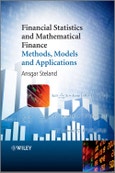Mathematical finance has grown into a huge area of research which requires a lot of care and a large number of sophisticated mathematical tools. Mathematically rigorous and yet accessible to advanced level practitioners and mathematicians alike, it considers various aspects of the application of statistical methods in finance and illustrates some of the many ways that statistical tools are used in financial applications.
Financial Statistics and Mathematical Finance:
- Provides an introduction to the basics of financial statistics and mathematical finance.
- Explains the use and importance of statistical methods in econometrics and financial engineering.
- Illustrates the importance of derivatives and calculus to aid understanding in methods and results.
- Looks at advanced topics such as martingale theory, stochastic processes and stochastic integration.
- Features examples throughout to illustrate applications in mathematical and statistical finance.
- Is supported by an accompanying website featuring R code and data sets.
Financial Statistics and Mathematical Finance introduces the financial methodology and the relevant mathematical tools in a style that is both mathematically rigorous and yet accessible to advanced level practitioners and mathematicians alike, both graduate students and researchers in statistics, finance, econometrics and business administration will benefit from this book.
Table of Contents
Preface xiAcknowledgements xv
1 Elementary Financial Calculus 1
1.1 Motivating Examples 1
1.2 Cashflows, interest rates, prices and returns 2
1.3 Elementary statistical analysis of returns 11
1.4 Financial instruments 28
1.5 A Primer on Option Pricing 32
1.6 Notes and further reading 42
2 Arbitrage Theory for the One-Period Model 45
2.1 Definitions and preliminaries 45
2.2 Linear pricing measures 47
2.3 More on arbitrage 50
2.4 Separation theorems in Rn 52
2.5 No-arbitrage and martingale measures 55
2.6 Arbitrage-free pricing of contingent claims 63
2.7 Construction of MartingaleMeasures: General Case 68
2.8 Complete financial markets 71
2.9 Notes and further reading 74
3 Financial Models in Discrete Time 75
3.1 Adapted stochastic processes in discrete time 77
3.2 Martingales and martingale differences 81
3.3 Stationarity 97
3.4 Linear Processes and ARMA Models 106
3.5 The frequency domain 118
3.6 Estimation of ARMA processes 126
3.7 (G)ARCH models 127
3.8 Long memory series 133
3.9 Notes and further reading 137
4 Arbitrage Theory for the Multi-Period Model 139
4.1 Definitions and preliminaries 139
4.2 Self-financing trading strategies 140
4.3 No-arbitrage and martingale measures 143
4.4 European claims on arbitrage-free markets 146
4.5 The martingale representation theorem in discrete time 150
4.6 The Cox-Ross-Rubinstein binomial model 151
4.7 The Black-Scholes formula 156
4.8 American options and contingent claims 161
4.9 Notes and further reading 165
5 Brownian Motion and Related Processes in Continuous Time 167
5.1 Preliminaries 167
5.2 Brownian Motion 170
5.3 Continuity and differentiability 181
5.4 Self-similarity and fractional Brownian motion 183
5.5 Counting processes 184
5.6 Levy processes 188
5.7 Notes and further reading 190
6 Itô Calculus 191
6.1 Total and quadratic variation 191
6.2 Stochastic Stieltjes integration 196
6.3 The Itô integral 199
6.4 Quadratic covariation 211
6.5 Itô's formula 212
6.6 Ito processes 215
6.7 Diffusion processes and ergodicity 222
6.8 Numerical approximations and statistical estimation 223
6.9 Notes and further reading 225
7 The Black-Scholes-Model 227
7.1 The model and first properties 227
7.2 Girsanov’s theorem 233
7.3 Equivalent martingale measure 237
7.4 Arbitrage-free pricing and hedging claims 238
7.5 The delta hedge 241
7.6 Time-dependent volatility 242
7.7 The generalized Black-Scholes model 244
7.8 Notes and further reading 246
8 Limit Theory for Discrete-Time Processes 249
8.1 Limit theorems for correlated time series 250
8.2 A regression model for financial time series 259
8.3 Limit theorems for martingale difference 263
8.4 Asymptotics 268
8.5 Density estimation and nonparametric regression 272
8.6 The CLT for linear processes 287
8.7 Mixing Processes 290
8.8 Limit Theorems for Mixing Processes 297
8.9 Notes and further reading 306
9 Special Topics 309
9.1 Copulas - and the 2008 financial crisis 309
9.2 Local linear nonparametric regression 322
9.3 Change-point detection and monitoring 333
9.4 Unit roots and random walk 345
9.5 Notes and further reading 363
A Appendix A 365
A.1 (Stochastic) Landau Symbols 365
A.2 Bochner’s Lemma 366
A.3 Conditional Expectation 367
A.4 Inequalities 368
A.5 Random Series 369
A.6 Local martingales in discrete time 369
Appendix B Weak Convergence and Central Limit Theorems 371
B.1 Convergence in distribution 371
B.2 Weak convergence 372
B.3 Prohorov's theorem 377
B.4 Sufficient criteria 379
B.5 More on Skorohod spaces 381
B.6 Central Limit Theorems for Martingale Differences 381
B.7 Functional central limit theorems 382
B.8 Strong Approximations 384
References 386
Index 409








